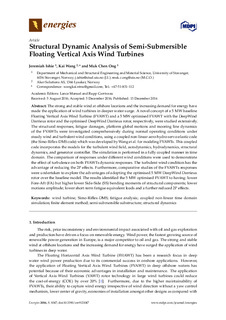| dc.contributor.author | Ishie, Jeremiah | |
| dc.contributor.author | Wang, Kai | |
| dc.contributor.author | Ong, Muk Chen | |
| dc.date.accessioned | 2017-01-11T10:16:33Z | |
| dc.date.available | 2017-01-11T10:16:33Z | |
| dc.date.issued | 2016-12 | |
| dc.identifier.citation | Energies 2016, 9(12), 1047; doi:10.3390/en9121047 | nb_NO |
| dc.identifier.uri | http://hdl.handle.net/11250/2427008 | |
| dc.description | Dette er en open access-artikkel som opprinnelig ble publisert i Energies 2016, 9(12) | nb_NO |
| dc.description.abstract | The strong and stable wind at offshore locations and the increasing demand for energy have made the application of wind turbines in deeper water surge. A novel concept of a 5 MW baseline Floating Vertical Axis Wind Turbine (FVAWT) and a 5 MW optimised FVAWT with the DeepWind Darrieus rotor and the optimised DeepWind Darrieus rotor, respectively, were studied extensively. The structural responses, fatigue damages, platform global motions and mooring line dynamics of the FVAWTs were investigated comprehensively during normal operating conditions under steady wind and turbulent wind conditions, using a coupled non-linear aero-hydro-servo-elastic code (the Simo-Riflex-DMS code) which was developed by Wang et al. for modeling FVAWTs. This coupled code incorporates the models for the turbulent wind field, aerodynamics, hydrodynamics, structural dynamics, and generator controller. The simulation is performed in a fully coupled manner in time domain. The comparison of responses under different wind conditions were used to demonstrate the effect of turbulence on both FVAWTs dynamic responses. The turbulent wind condition has the advantage of reducing the 2P effects. Furthermore, comparative studies of the FVAWTs responses were undertaken to explore the advantages of adopting the optimised 5 MW DeepWind Darrieus rotor over the baseline model. The results identified the 5 MW optimised FVAWT to having: lower Fore-Aft (FA) but higher lower Side-Side (SS) bending moments of structural components; lower motions amplitude; lower short-term fatigue equivalent loads and a further reduced 2P effects. | nb_NO |
| dc.language.iso | eng | nb_NO |
| dc.publisher | MDPI | nb_NO |
| dc.rights | Navngivelse 4.0 Internasjonal | * |
| dc.rights.uri | http://creativecommons.org/licenses/by/4.0/deed.no | * |
| dc.subject | vindturbiner | nb_NO |
| dc.subject | wind turbines | nb_NO |
| dc.subject | Simo-Riflex-DMS | nb_NO |
| dc.subject | fatigue analysis | nb_NO |
| dc.subject | coupled non-linear time domain simulation | nb_NO |
| dc.subject | finite element method | nb_NO |
| dc.subject | semi-submersible substructure | nb_NO |
| dc.subject | structural dynamics | nb_NO |
| dc.title | Structural dynamic analysis of semi-submersible floating vertical axis wind turbines | nb_NO |
| dc.type | Journal article | nb_NO |
| dc.type | Peer reviewed | nb_NO |
| dc.rights.holder | © 2016 Forfatterne | nb_NO |
| dc.subject.nsi | VDP::Teknologi: 500 | nb_NO |
| dc.source.volume | 9 | nb_NO |
| dc.source.journal | Energies | nb_NO |
| dc.source.issue | 12 | nb_NO |
| dc.identifier.doi | 10.3390/en9121047 | |

